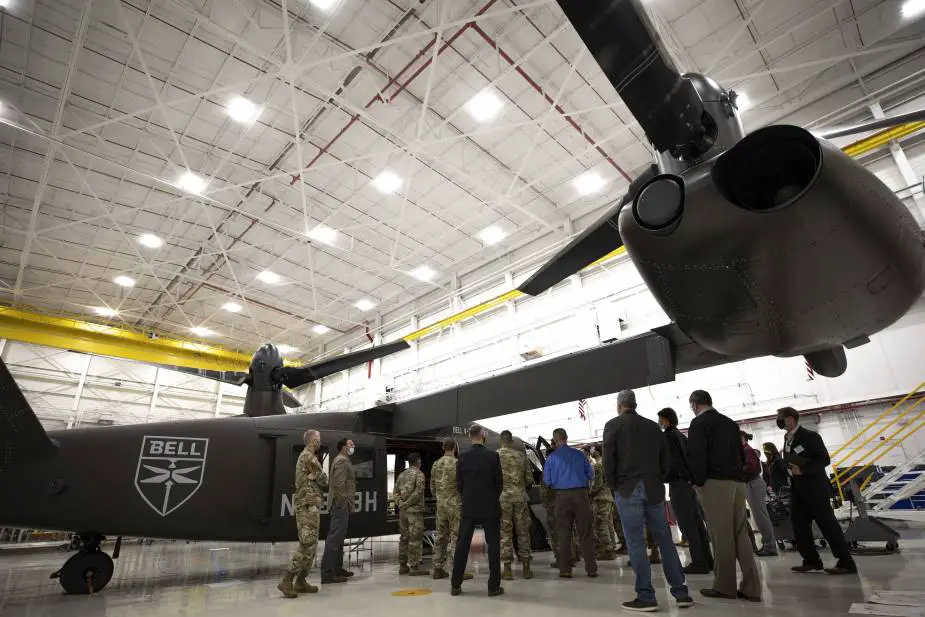US Army aviation undergoing changes to meet MDO requirements
Lorem ipsum dolor sit amet, consectetur adipisicing elit, sed do eiusmod tempor incididunt ut labore et dolore magna aliqua. Ut enim ad minim veniam, quis nostrud exercitation ullamco laboris nisi ut aliquip ex ea commodo consequat. Duis aute irure dolor in reprehenderit in voluptate velit esse cillum dolore eu fugiat nulla pariatur. Excepteur sint occaecat cupidatat non proident, sunt in culpa qui officia deserunt mollit anim id est laborum.
Follow Army Recognition on Google News at this link

Soldiers from 3rd Brigade Combat Team, 101st Airborne Division, visit Bell's flight facility in Arlington, Texas, Oct. 28, 2020. The Soldiers provided feedback on the V-280 Valor cabin configuration that will inform Future Long-Range Assault Aircraft requirements from a user's perspective. (Picture source: Luke Allen)
Army aviation serves as the aerial maneuver arm of combined arms maneuver in support of the ground force commanders, Francis said. Continued modernization is critical to achieve necessary transformational capabilities as the Army prepares for large-scale combat operations.
As the MDO concept shifts to doctrine and then FVL platforms and other new aviation capabilities take off, the Army's aerial-maneuver element will need to evolve, Francis said during the Association of the U.S. Army's Global Force Next virtual conference Wednesday. Francis said changes to Army Aviation Field Manual 3-04 and all other associated materials could happen sooner than expected as the service moves to support joint combined arms and maneuver operations. Army aviation is currently transforming organizations to move beyond a modular brigade-centric operations approach to support division and corps-sized operations. This change will also prepare the Army for rapid integration of FVL capabilities as they come online, he said.
Adjustments to training are also being addressed to incorporate how aviators and maintainers will fight or support operations across all domains -- land, maritime, air, space, and cyberspace. "We are changing the way we address emergency procedures at low altitudes, and we are training our aviation forces to fly low once again," Francis said. "This is not new to Army aviation, but it is relatively new to this generation." Pilots proficient at flying in terrain-height altitudes can stay below a radar threat and "survive, fight and win" on a future battlefield, he added.
Another aspect of training includes the proper on-boarding of the Future Attack Reconnaissance Aircraft and Future Long-Range Assault Aircraft. As the Army introduces its newest aerial capability, collective training will be necessary to ensure mission readiness as more FVL units materialize across the force.
Leadership development is also under revision as the Army shifts its focus to large-scale operations, Francis said. Personnel will need to learn how to operate and sustain aviation capabilities throughout a dispersed environment and converge effects when called upon by ground force commanders. "This is going to cause leaders to think differently -- or maintainers to maintain differently," Francis said, adding that aviation training requirements and airframe designs must be able to support a distributed operation.
EDGE 21
In May, Army aviation will also move forward with its first Experimental Demonstration Gateway Exercise 2021 at Dugway Proving Ground, Utah, said Maj. Gen. Walter Rugen, FVL Cross-Functional Team director.
With the recent success of Project Convergence 20, EDGE 21 will use aviation, network, and space capabilities to advance combined joint all-domain command and control efforts, or CJADC2, across the lower-tier air domain. "We are going to take our high-fidelity modeling, these 100,000 engineered runs that we've done in a physics-based modeling with the (Future Attack Reconnaissance Aircraft) ecosystem, and fight that in a scenario where we use joint long-range fires," he said.
The exercise will show the progression of sensor-to-shooter systems, as the Army looks to close joint kill chains in an agile and effective manner, Rugen added. EDGE 21 will also include an electronic warfare element to create a realistic MDO scenario against an Integrated Visual Augmentation System-enabled aircraft.
MOSA
A modular open systems approach, or MOSA, is also needed to bridge the capability gap between current and future aerial systems, Rugen said. An industry partner's willingness to adopt MOSA, along with other government-defined interfaces and standards, will be critical to the way ahead. "MOSA, in general, specifically applies to the (cross-functional team’s) line of effort, but we are trying to bring it across our entire fleet of aircraft. It goes to that second priority of ensuring readiness and relevance of our enduring fleet," said Brig. Gen. Robert L. Barrie Jr., head of Program Executive Office-Aviation.
As the Army continues to prioritize the need for FVL capabilities, targeted modernization efforts to the service’s enduring airframes will require an open-system architecture to support. Aviation leaders must continue to explore all options to balance the Army's future mission, Barrie said.


























